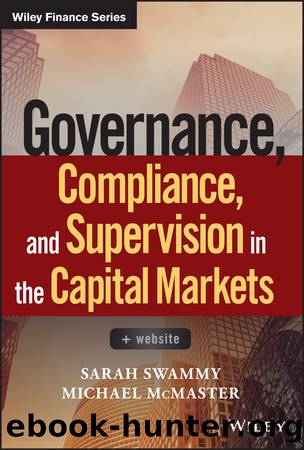Governance, Compliance and Supervision in the Capital Markets by Sarah Swammy & Michael McMaster

Author:Sarah Swammy & Michael McMaster [Swammy, Sarah & McMaster, Michael]
Language: eng
Format: epub
ISBN: 9781119380641
Published: 2018-05-22T00:00:00+00:00
ASSESSING THE EFFECTIVENESS OF THE PROGRAM
The first step in assessing the effectiveness of a compliance program is to understand all of the laws, rules, and regulations applicable to a firm's business. Without performing this initial task, it is impossible to know for certain whether the firm is addressing all its regulatory requirements. Here, the CCO needs to compile, maintain, and update (as necessary) an inventory of laws, rules, and regulations applicable to the firm's business activities and to ensure new or amended laws, rules, and regulations are added to the inventory as they are approved and become effective.
The inventory of applicable laws, rules, and regulations is the starting point for the compliance program. Once completed, the CCO should map all existing firm policies and procedures to this inventory. The purpose of this exercise is to make sure the firm has implemented policies and procedures to address all the relevant laws, rules, and regulations. If there are gaps, then those gaps must be remediated in a timely manner. Next, to ensure there is an effective supervisory process, the CCO should verify that every policy and procedure mapped to the inventory of laws, rules, and regulations has a written supervisory procedure to detail the supervisor's obligations with respect to that policy. In this case, the CCO wants to ensure that there is supervision for all of the policies and procedures applicable to the business. If there are any gaps, these gaps should be remediated in a timely manner with the business supervisors for those businesses.
Next, the CCO will want to do a risk assessment of the laws, rules, and regulations that are applicable to the firm's business. Firms may use various types of systems to rate the risks of the laws, rules, and regulations, but a simplified system may be to review the inventory and apply a threeâtier rating system to each law, rule, or regulation of high, medium, or low risk. A firm should define what each of these risk categories means, but another simplified system would be to define laws, rules, or regulations as high risk, where violations by the firm would have a significant effect on customers and/or are matters that would lead to significant regulatory implications such as large fines, censure, and/or a determination by a regulator that such violations are matters requiring immediate attention of the firm to rectify. Medium risk could be those that would have a small impact to customers, and/or regulators may have some concerns and implement small fines or require firms to implement certain amended processes but not as significant as high risk. Lowârisk laws, rules, and regulations could be those where violations will have little to no effect on customers, and regulators would mostly likely require firms to amend their processes but not result in fines or censure.
As a result of this risk rating system, the CCO could determine a time schedule for a firm to monitor (and possibly audit) or test a business's policies, procedures, and written supervisory procedures. For example,
Download
This site does not store any files on its server. We only index and link to content provided by other sites. Please contact the content providers to delete copyright contents if any and email us, we'll remove relevant links or contents immediately.
International Integration of the Brazilian Economy by Elias C. Grivoyannis(57422)
The Radium Girls by Kate Moore(10929)
Turbulence by E. J. Noyes(7062)
Nudge - Improving Decisions about Health, Wealth, and Happiness by Thaler Sunstein(6648)
The Black Swan by Nassim Nicholas Taleb(6213)
Pioneering Portfolio Management by David F. Swensen(5619)
Rich Dad Poor Dad by Robert T. Kiyosaki(5174)
Zero to One by Peter Thiel(4841)
Man-made Catastrophes and Risk Information Concealment by Dmitry Chernov & Didier Sornette(4755)
Secrecy World by Jake Bernstein(3793)
Millionaire: The Philanderer, Gambler, and Duelist Who Invented Modern Finance by Janet Gleeson(3578)
Skin in the Game by Nassim Nicholas Taleb(3488)
The Age of Surveillance Capitalism by Shoshana Zuboff(3435)
The Money Culture by Michael Lewis(3296)
Skin in the Game: Hidden Asymmetries in Daily Life by Nassim Nicholas Taleb(3279)
Bullshit Jobs by David Graeber(3194)
The Dhandho Investor by Mohnish Pabrai(3181)
The Wisdom of Finance by Mihir Desai(3093)
Blockchain Basics by Daniel Drescher(2902)
